Heavy Metals Concentration in Textile and Garments Industries’ Wastewater of Bhaluka Industrial Area, Mymensingh, Bangladesh
Biddut Chandra Sarker1 * , Md. Abdul Baten1 , Md. Ekram Ul-Haque2 , Alok Kumar Das3 , Ahmed Hossain4 and Md. Zahedul Hasan1
1
Department of Environmental Science,
Bangladesh Agricultural University,
Mymensingh,
2202
Bangladesh
2
Soil Science Division,
Bangladesh Institute of Nuclear Agriculture (BINA),
Mymensingh,
2202
Bangladesh
3
Department of Environmental Science and Resource Management,
Mawlana Bhashani Science and Technology University,
Tangail,
1902
Bangladesh
4
Department of Biotechnology,
Bangladesh Agricultural University,
Mymensingh,
2202
Bangladesh
DOI: http://dx.doi.org/10.12944/CWE.10.1.07
An investigation was made to ascertain heavy metals concentration in effluent samples collected from textile industries located at Bhaluka industrial area, Mymensingh, Bangladesh during August to November, 2013. Atomic absorption spectrometer (AAS) was used to evaluate the concentration of Zinc (Zn), Copper (Cu), Nickel (Ni), Cadmium (Cd), Chromium (Cr) and Lead (Pb) in the samples. The study revealed that heavy metals were present in variable amounts, where the concentrations of Cu (0.0405 ppm) and Pb (0.0003 ppm) were found lower than recommended level for industrial waste water. Among the present trace metals, the highest concentration (0.2-1.0 ppm) was found in Zn. Although the concentration is suitable for irrigation, it is unsafe for aquaculture. Besides, all of the wastewater samples possessed no Cr, Cd and Ni, which comprised less of the minimum acceptance level, indicating no possibility of contamination. However, comparing findings of this study with the safe limits for industrial wastewater, it can be concluded that the waste water of the study area except some sampling sites can be used for irrigation and aquaculture.
Copy the following to cite this article:
Sarker B. C, Baten M. A, Eqram-Ul Haque M, Das A. K, Hossain A, Hasan M. Z. Heavy Metals Concentration in Textile and Garments Industries’ Wastewater of Bhaluka Industrial Area, Mymensingh, Bangladesh. Curr World Environ 2015;10(1). DOI:http://dx.doi.org/10.12944/CWE.10.1.07
Copy the following to cite this URL:
Sarker B. C, Baten M. A, Eqram-Ul Haque M, Das A. K, Hossain A, Hasan M. Z. Heavy Metals Concentration in Textile and Garments Industries’ Wastewater of Bhaluka Industrial Area, Mymensingh, Bangladesh. Curr World Environ 2015;10(1). Available from: http://cwejournal.org?p=604/
Download article (pdf)
Citation Manager
Publish History
Select type of program for download
| Endnote EndNote format (Mac & Win) | |
| Reference Manager Ris format (Win only) | |
| Procite Ris format (Win only) | |
| Medlars Format | |
| RefWorks Format RefWorks format (Mac & Win) | |
| BibTex Format BibTex format (Mac & Win) |
Article Publishing History
| Received: | 2014-11-28 |
|---|---|
| Accepted: | 2015-01-29 |
Introduction
In the modern world, environmental pollution has been recognized as one of the major problems. The activities of human society via industry influences biogeochemical cycles and this have led to various irreversible changes in our environment.1,2 As a result, undesirable effects of poor environmental circumstances on human health are mostly manifested in environment, predominantly in developing countries where urbanization, industrialization and rapid population growth are taking place on an unprecedented scale.3-5
The irregular disposal of industrial wastes has created pollution problems since this waste is disseminated in the environment or is accumulated in sediments, aquatic organisms, and water.6 Majority of manufacturing processes are water based and a considerable volume of effluent is ejected to the environment in either treated or inadequately treated form, leading to surface and ground water pollution.7 Industry has contributed to serious and widespread deterioration in the quality of water, land and air in Bangladesh.8 Textile is the most important sector of Bangladesh’s economy that utilizes a large quantity of water in production process and consequently highly polluted and toxic taste waters are discharged into sewers and drains without any kind of treatment.9 Textile and Garments’ washing & dyeing sections have been condemned as being one of the world’s most offenders in terms of pollution.10 Textile industries are the major sources of pollution and contributors of metal contaminants to the environment. Although most of the industries are supposed to have effluent treatment plant, however, so far only a few industries have implemented it, although treatment alternatives are either; complex, energy consuming, expensive or applicable to an indisputable portion of the world due to proficient work force requirement.7 A large number of factories are operating without the ETPs, violating the existing laws.11
Heavy metals are natural components of the Earth’s crust. They cannot be degraded or destroyed. Today, contamination of water by toxic heavy metals in the form of wastes effluents from industries is a worldwide environmental problem. To a small extent they enter our bodies via food, drinking water and air. As trace elements, some heavy metals (e.g. lead, chromium, copper, mercury, manganese, selenium, zinc etc) are essential to maintain the metabolism of the human body. However, at higher concentrations they can lead to poisoning.12 Industrial effluents discharged from textiles contain a higher amount of metals. These effluents are released on the land as well as discharged into the surface water which ultimately end up in ground water by leaching and lead to contamination of it due to accumulation of toxic metallic components.13 Thus industrial effluents induce a wide range of environmental problems, more complex and critical health hazards in developing countries like Bangladesh as well as in other developed countries. Industrial effluent is a main source of direct and often continuous input of pollutants into aquatic ecosystems with long-term implications on ecosystem functioning.14-17
Heavy metals are natural components of the Earth’s crust. They cannot be degraded or destroyed. Today, contamination of water by toxic heavy metals in the form of wastes effluents from industries is a worldwide environmental problem. To a small extent they enter our bodies via food, drinking water and air. As trace elements, some heavy metals (e.g. lead, chromium, copper, mercury, manganese, selenium, zinc etc) are essential to maintain the metabolism of the human body. However, at higher concentrations they can lead to poisoning.12 Effluents discharged from textiles contain a higher amount of metals. These effluents are released on the land as well as discharged into the surface water which ultimately end up in ground water by leaching and lead to contamination of it due to accumulation of toxic metallic components.13 Thus industrial effluents induce a wide range of environmental problems, more complex and critical health hazards in developing countries like Bangladesh as well as in other developed countries. Industrial effluent is a main source of direct and often continuous input of pollutants into aquatic ecosystems with long-term implications on ecosystem functioning.14-17
A systematic study was required to ascertain the status of metals in industrial effluents mainly textile and garments. Keeping these facts in the mind therefore, the present study was undertaken to assess the heavy metal concentrations of the wastewater dumping site at Bhaluka industrial area, Mymensingh, Bangladesh.
Materials and Methods
Study Area Textile and garments industries, situated in Habirbari union under Bhaluka upazila which is approximately within latitude at 24.3750ºN and longitude at 90.3778°E (Fig. 1) were selected to evaluate heavy metal concentration in effluents. 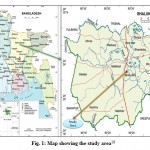 |
Figure 1: Map showing the study area |
Sample Collection
The industrial effluent’s samples (E1-E12) were collected during September 2013 from effluent discharging drains originated from six different industries’ outlet. The sampling points (S1-S12) were designed in relation to industries as depicted by Fig. 2. Samples were preserved for laboratory analyses maintaining with proper direction.
Analytical Procedures
Determination of Heavy Metals
Determination of different heavy metals viz. Zn, Cu, Ni, Cd, Cr and Pb in water samples was done by an Atomic Absorption Spectrophotometer (AAS) (Varian Spectra AA55B, Australia) as suggested by APHA.19 A standard line was prepared by plotting the absorbance reading on Y-axis versus the concentration of each standard solution of metal on X-axis. The concentration of metal was calculated in the water samples of interest by plotting the AAS reading on the standard line.
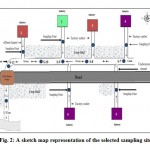 |
Figure 2: A sketch map representation |
Data Analysis
Descriptive statistical parameters were calculated with SPSS software package and Microsoft Office Excel. Various descriptive statistical measures such as range, number, percentage, mean, standard deviation (SD), etc. were used for categorization and describing the variables.
Results and Discussion
Heavy Metal Concentrations
Descriptive statistics of the data including waste water parameters of six metal concentrations are shown in Table 1. Among the studied heavy metals the most dominant metal was Zn followed by Cu, Cd, Pb, Cr and Ni. Distinct variation was observed among heavy metal contents in the effluent samples.
The amount of Cu varied from 0 to 0.356 ppm(Table 1), with an average value of 0.0405 ppm, which indicates this effluent can be safely used for irrigation as well as other purposes in respect of Cu concentration. Among all samples, 11 samples were found within the recommended limit except E6, for irrigation where its acceptable limit is 0.20 ppm.
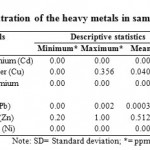 |
Table1: Available concentration of the heavy metals in samples (E1-E12) where, n =12 Click here to View table |
According to Ayers and Westcot20 Concentration of Zn varied from 0.2 to 1 ppm where the mean was 0.512 ppm (Table 1) and standard deviation was 0.208. The highest concentration (1.0 ppm) was found at the point E6 and the lowest concentration (0.2 ppm) was observed at E.12
A nearly similar Zn concentration was recorded at E5 (0.65 ppm), E9 (0.64 ppm) and E11 (0.65 ppm) and same (0.34 ppm) in E4 and E8. According to Ayers and Westcot,20 the maximum permissible limit of Zn in irrigation water is 2.00 ppm. Considering standard limit, all effluent samples were found within the maximum permissible limits which were suitable for irrigation in respect of Zn21; hence Zn concentration of the samples is higher than the standard value for aquaculture.22 Therefore, the water was harmful for aquatic life and thus unsuitable for aquaculture. The degree of relationship between available Zn content and Cu (Fig. 3) of the samples revealed that the strongest positive correlation existed between Zn and Cu at 5% level (2-tailed) of significance where the correlation value (r) = 0.707*.
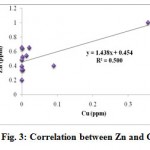 |
Figure 3: Correlation between Zn and Cu |
Concentration of Pb, ranging from 0 to 0.002 ppm with an average value of 0.0003 ppm and standard deviation of 0.00065 indicated that the analyzed effluents were free from lead (Pb) contamination20 and thus suitable for irrigation21 and aquaculture.22 Correlation between concentration of available Cu, Pb (Fig. 4) and Zn, Pb (Fig. 5) of the water samples had a negative relationship where the correlation values (r) were 0.158 and 0.0447, respectively.
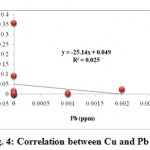 |
Figure 4: Correlation between Cu and Pb |
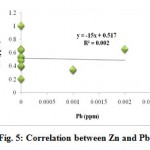 |
Figure 5: Correlation between Zn and Pb |
Experimental result also revealed that Cr, Cd and Ni were found as trace amount in effluent samples (Table 1), leading to the decision that the samples were free from Chromium, Cadmium23 and Nickel contamination.
Conclusion
On the basis of results of the experiment it can be stated that level of heavy metal contamination in collected waste waters from textile and garments industries was generally low and showed an acceptable limit. The objectionable appearance of canal water can be attributed to the discharge of untreated industrial wastewaters. Though some of the chemical elements are beneficial for crops, plants and aquaculture up to a certain limit, it may be potentially detrimental beyond that.
Acknowledgement
The authors are thankful to the personnel of Soil Science division, Bangladesh Institute of Nuclear Agriculture (BINA), Mymensingh, Bangladesh, for providing necessary support during study period.
References
- Khairiah J., Ding-Woei Y., Habibah J., Ahmad-Mahir R., Aminah A. and Ismail B.S., Concentration of Heavy Metals in Guava Plant Parts and Soil in the Sungai Wangi Plantation, Perak, Malaysia. Inter. J. Agric Res., 4: 310-316 (2009).
- Cheraghi M., Lorestani B. and Yousefi N., Effect of Waste Water on Heavy Metal Accumulation in Hamedan Province Vegetables. Inter. J. Bot., 5: 190-193 (2009).
- Duzgoren-Aydin N.S., Sources and characteristics of lead pollution in the urban environment of Guangzhou. Sci. Total Environ., 385: 182-195 (2007).
- Jiries A.G., Chemical Evaluation of Treated Sewage Effluents in Karak Province and its Suitability for Irrigation Purposes. Pak. J. Biolog. Sci., 4: 1400-1402 (2001).
- Akan J.C., Moses E.A. and Ogugbuaja V.O., Determination of Pollutant Levels in Mario Jose Tannery Effluents from Kano Metropolis, Nigeria. J. Appl. Sci., 7: 527-530 (2007).
- Singh R, Verma R.S, Yadav Y. Use of Industrial Waste Water for Agricultural Purpose: Pb and Cd in Vegetables in Bikaner City, India. Curr. World Environ., 7(2): 287-286 (2012).
- Sarker B.C., Basak B. and Islam M.S., Chromium Effects of Tannery Waste Water and Appraisal of Toxicity Strength Reduction and Alternative Treatment. Inter. J. Agron. Agric. Res., 3: 23-35 (2013).
- Hoque A. and Clarke A., Greening of industries in Bangladesh: pollution prevention practices. Journal of Cleaner Production, 51: 47-56 (2013). doi:10.1016/j.jclepro.2012.09.008
- Chindah A.C., Braide A.S. and Sibeudu O.C., Distribution of hydrocarbons and heavy metals in sediment and a crustacean (shrimps- Penaeus notialis) from the bonny/new Calabar river estuary, Niger Delta. Ajeam-Ragee, 9: 1-14 (2004).
- Islam M. M., Mahmud K., Faruk O. and Billah M. S., Textile dyeing industries in Bangladesh for sustainable development. International Journal of Environmental Science and Development, 2(6): 428-436 (2011).
- Sultana Z., Ali M., Uddin M. and Haque M., Implementation of Effluent Treatment Plants for Waste Water Treatment, Journal of Environmental Protection, 4 (3): 301-308 (2013). doi:10.4236/jep.2013.43035
- Talwar R, Agrawal S, Bajpai A, Malik S. Assessment of Concentration and Variations due to Seasonal Effect on the Presence of Heavy Metals in the Water of Upper Lake, Bhopal. Curr. World Environ., 9(2): 421-425 (2014).
- Malarkodi M., Krishnasamy R., Kumaraperumal R. and Chitdeshwari T., Characterization of heavy metal contaminated soils of Coimbatore district in Tamil Nadu. J. Agron., 6: 147-150 (2007).
- Odeigah C. and Osanyinpeju O., Genotoxic effects of two industrial effluents and ethyl methane sulfonite in Clarias lazera. Food Chem. Toxicol., 33: 501-505 (1995).
- Chan Y.K., Wong C.K., Hsieh D.P.H., Lau T.K. and Wong P.K., Application of a toxicity identification evaluation for a sample of effluent discharged from a dyeing factory in Hong Kong. Environ. Toxicol., 18: 312-316 (2003).
- Lah B, Gorjane G., Nekrep F.V. and Marinsek L.R., Comet assay of waste water geno-toxicity using yeast cells. Bull. Environ. Contamin. Toxicol., 72: 607-616 (2004).
- Smolders R., Bervoets L. and Blust L., In situ and laboratory bioassays to evaluate the impact of effluent discharges on receiving aquatic ecosystems. Environ. Pollut., 132: 231-243 (2004).
- Banglapedia, National Encyclopedia of Bangladesh, Asiatic Society of Bangladesh (2008).
- APHA (American Public Health Association), Standard Methods for the Examination of Water and Waste Water, 19th Ed. Washington DC, p: 1019 (1995).
- Ayers R.S. and Westcot D.W., Water Quality for Agriculture (FAO irrigation and drainage paper), 29: 4096 (1985).
- Ayers R.S. and Westcot D.W., Water Quality for Agriculture (FAO irrigation and drainage paper), 29: 81 (1976).
- Meade J.W., Aquaculture Management, CBS Publishers & Distributors, New Delhi, India, p: 9 (1998).
- DoE (Department of Environment), Report on the environmental quality standards for Bangladesh, Ministry of Environment, Dhaka 1000, Bangladesh (1991).






